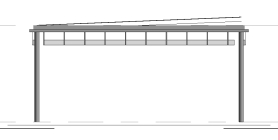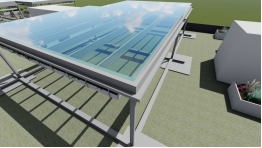1. Introduction
With the rapid economic growth, the population of cities has significantly increased which driving the rapid development of urbanization. However, the rapid urbanization process has brought many environmental issues due to the increasing number of urban buildings. With the expansion of urban construction, a large amount of land is used for the construction of high-rise buildings. This leads to the urban heat island effect, air pollution, flood hazards, noise pollution, and other problems. These problems have a negative impact on the quality of life and physical and mental health of urban residents and have caused damage to the overall ecological environment of the city. In order to solve these problems, the roof garden which was an innovation of green building design began to attract people's attention.
Roof gardens are green spaces located on the roofs or balconies of buildings. Compared to traditional urban landscapes, roof gardens can serve as a bridge for interaction between humans and nature, and between buildings and the environment. Therefore, roof gardens play a unique role in improving urban climate and environmental quality. Although their initial costs are higher, the lifecycle of roof gardens can be two to three times longer than traditional rooftops. The lifespan of roofs could be longer [1]. It should be noted that current research is based on a 20-year expected lifespan, while the actual lifespan may exceed 40 years which means that the lifecycle costs could be acceptable. In addition, the roof garden also has a significant improvement in the sound insulation of the roof system which can reduce the impact of outdoor noise. By absorbing noise pollution, it also helps to improve the overall environmental quality of cities [2]. Finally, roof gardens can reduce stormwater runoff by retaining water. Roof garden plays a positive role in alleviating the urban watershed syndrome by delaying the peak and time of stormwater runoff [3].
Chengdu is a mega-city in China with a population of over 20 million. With the rapid advancement of urbanization, the built-up area of Chengdu has expanded from 60 square kilometers to 950 square kilometers [4]. This urban expansion has resulted in a trend of warming and drying in Chengdu [5]. Due to its high population density and rapid economic growth, climate change issues in Chengdu may cause severe socio-economic problems and health issues for residents [6]. In addition, Chengdu has an urban plan to build a garden city to further improve the economy and residents' health issues.
Therefore, based on the climate and environmental characteristics of Chengdu, this paper aims to design a rooftop garden that is in line with the local features, to contribute to improving the environmental conditions in the region. Firstly, this paper will conduct an in-depth analysis of the climate and environmental issues in Chengdu based on climate data, to better understand the challenges faced by the region and further analyze the problems in the urbanization process of Chengdu. Secondly, based on considering the principles of safe load-bearing, waterproof drainage, ecological environmental protection, artistry, and economy, this paper will carry out localization design for the roof garden according to the actual situation of Chengdu. Finally, the overall design will be presented by rendering software Lumion, and corresponding solutions will be provided for specific climate issues in Chengdu. Such research and design are expected to make a positive contribution to improving the environmental conditions in Chengdu, especially in addressing climate-related issues triggered by the urbanization process.
2. Roof garden
2.1. Concept and advantages of roof garden
Roof gardens refer to the utilization of rooftop or balcony spaces of buildings to create green areas, thereby increasing the overall green space of the building. They can play a variety of functions of roof gardens through measures such as opening to residents or the public. Firstly, as part of urban green landscapes, roof gardens enhance the aesthetics of the city. The green landscape not only plays a role in improving the urban scenery but also makes the urban landscape more hierarchical due to the effective utilization of the originally abandoned and homogenized urban roofs and side walls [7]. Secondly, roof gardens offer unique ecological benefits [8]. They provide insulation and thermal regulation through the use of soil substrates. The vegetation in these gardens helps purify the air, reduce noise pollution, and protect biodiversity by providing habitats for plants and animals. Lastly, roof gardens contribute to climate regulation in cities, thus mitigating the urban heat island effect. Promoting roof gardens citywide can effectively reduce the urban heat island effect and overall city temperatures.
2.2. Design concept
The design concept for rooftop gardens mainly follows five aspects:
(1) Safety and Load-Bearing Principle
The design of a roof garden should consider the load-bearing capacity of the underlying roof. This can be achieved by reducing the weight of the roof garden structure or by designing a drainage system to minimize the time rainwater stays on the roof garden to ensure that it does not exceed the safe load capacity of the roof.
(2) Waterproofing and Drainage Principle
The design and construction of a roof garden should not compromise the integrity of the existing waterproof layer of the roof. A suitable drainage system should be designed to prevent prolonged water accumulation on the roof garden.
(3) Ecological and Environmental Principle
As a green and environmentally friendly infrastructure, a roof garden should ensure a greening coverage of 50% to 70% to allow plants to grow properly [7]. Potential pollution issues should be avoided during construction and later maintenance processes.
(4) Artistic Principle
As an important part of an urban landscape, aesthetic design should be maintained as much as possible to enhance the beauty of the city.
(5) Economic Principle
Roof gardens as infrastructure projects, the universality of the overall design should be considered to facilitate its application. Therefore, the design should focus on minimizing maintenance costs and initial construction expenses to facilitate its implementation and promotion.
2.3. Study area and method
2.3.1. Study area. The presumed location for the design of the roof garden is Chengdu, China. Chengdu is the capital city of Sichuan Province and is located in the western part of Sichuan Province (Figure 1). Chengdu has a subtropical monsoon climate, with an average annual temperature of 16 degrees Celsius. It is characterized by low wind speeds, limited sunshine hours, high precipitation, and high humidity [9].
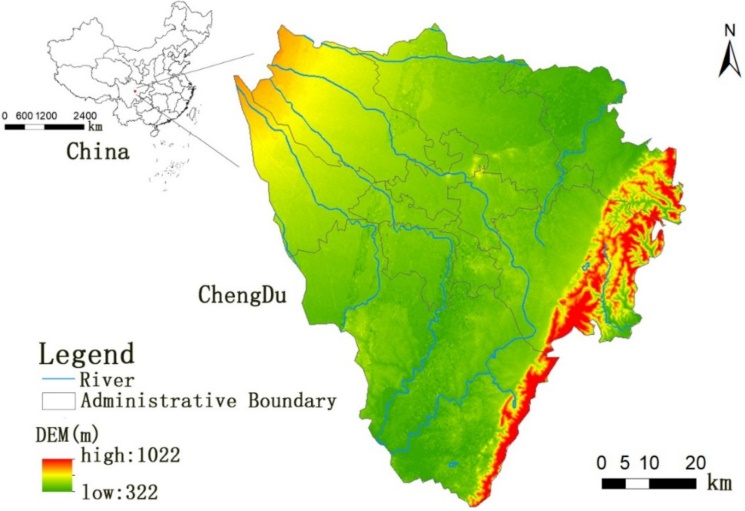
Figure 1. Location map of Chengdu [10].
Due to the accelerated process of urbanization, Chengdu city is facing problems such as air quality problem and noise pollution. Firstly, although the air quality in Chengdu has gradually improved, some pollutants still do not meet the standards. This is reflected in the high concentrations of ozone and particulate matter. Research suggests that pollutants such as PM2.5 and particulate matter have a significant impact on increasing skin diseases such as eczema. Since the skin is the primary barrier against air pollutants, severe air pollution can trigger or exacerbate skin diseases [11]. Ozone can react with biomolecules in the skin, thereby adversely affecting the skin health of the general population [12]. In addition, the current level of noise pollution in Chengdu remains relatively high, generally at a fourth-grade level, reaching approximately 70 decibels [13]. These noises can hurt residents' daily mood and auditory health.
Therefore, this paper will consider the current urban problems of Chengdu to design a roof garden that is more suitable for Chengdu.
2.3.2. Method. The main method of this study is to utilize Building Information Modeling (BIM) technology for three-dimensional modeling of buildings. BIM technology provides realistic and direct construction assistance based on the geometric shape, material attributes, and appearance parameters of the design. Autodesk Revit software is chosen for three-dimensional modeling in this paper. This software enables effective integration with other software and has good compatibility with subsequent data processing or rendering software. Moreover, any changes during the design process can be promptly applied, reducing errors in design and drafting during the BIM design process to improve the efficiency of design [14].
(1) Model Design
The model design process is based on the design concept. Firstly, the infrastructure in the roof garden is modeled, including pergolas for plant growth and resident relaxation. In the modeling process, the bottom support, support columns, and the roof with a certain tilt angle are sequentially modeled. Next, small flower pots accompanying the pergola and large flower pots below are modeled and the materials for the relevant parts are designed. Then, the assumed area of the roof garden is defined within a specific range, and the layout of the roof garden is designed. Finally, the modeling of each layer and the building section of the entire site is completed.
(2) Visual Rendering
In this study, Lumion software is utilized for model rendering. This software is commonly used for architectural model rendering and video production. It can transform models from sketches into finished visual images [15]. This process involves optimizing the materials of existing models and completing the vegetation model with Lumion's extensive library of pre-built plant models. This approach highlights the artistic principles of the roof garden through intuitive visual effects. Additionally, through the character model, the activities of residents in the roof garden are embodied which can make the design of the roof garden more excellent.
3. Function introduction of the designed roof garden
3.1. Leisure and entertainment function
In the design of this function, the primary consideration is to provide sufficient leisure and entertainment places for residents, as shown in Figure 2. As indicated in Figure 2, the platform designed for plant growth in the roof garden takes the form of a pavilion, providing a resting area for residents. In addition, amenities such as benches are provided which can allow residents to engage in reading or relaxation. This design concept satisfies the passive recreational needs of residents [16]. Furthermore, flower beds are incorporated into the roof garden, offering residents the opportunity to plant their favorite plants, and flowers or engage in other gardening activities. This design not only enhances the sense of participation of residents but also fulfills their active recreational needs. This participatory design allows residents to actively engage in the management and creation of the roof garden, thereby experiencing deeper enjoyment.
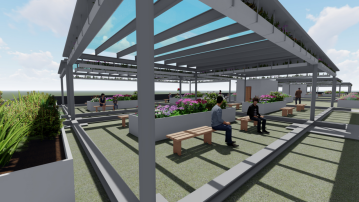
Figure 2. Recreation function diagram.
Overall, through these design strategies, the roof garden becomes not only a place for leisure and entertainment but also promotes socialization and interaction among residents. It provides a pleasant space that contributes to improving the quality of urban life.
3.2. Improve air quality
Research conducted by GSA and others has shown that roof gardens can effectively mitigate the high levels of particulate pollutants in the air. Taking Washington as an example, this study found that roof gardens with a roof area of 75 million square feet, can remove 58 tons of air pollutants on a monthly basis. These pollutants include not only particulate matter but also sulfur dioxide, nitrogen dioxide, and other gaseous pollutants [17]. Therefore, this paper intends to apply this finding to the design of roof gardens in Chengdu. This design considers the air purification abilities of different types of vegetation and selects plant species suitably.
In the roof garden, four main types of vegetation can be placed: landscaping plants, potted plants, ground cover plants, and climbing plants. Landscaping plants are relatively rich, and the landscape hierarchy is clear. The overall effect of landscaping plants is more beautiful. However, these plants have higher costs and heavier weight. Potted plants, on the other hand, are small in size and lightweight but lack a distinct landscape hierarchy. Ground cover plants have low costs, light loads, and are easy to manage, but their ornamental value is relatively poor. Climbing plants offer unique aesthetics and landscape effects, but require long-term management and investment from the caretaker [18]. Considering the load-bearing capacity, aesthetics, and green environmental factors of the roof garden, small trees, shrubs, and lawns are ultimately chosen as the main vegetation.
To ensure that the selected plants meet the construction requirements of the roof garden and are well adapted to the local natural climate in Chengdu. The following plant species are chosen: hibiscus, osmanthus, geranium, magnolia, purple-leaved plum, and Cephalotaxus Harrington for a small deciduous tree. Camellia, rose, Nandina, cercis, holly, and primula are selected for shrubs. As for herbaceous plants, fescue grass, hanging basket grass, clover, and moneywort are chosen [19] [20].
In conclusion, through the selection and proper arrangement of vegetation, targeted solutions can be provided for the air quality issues in Chengdu. On the one hand, the design can enhance the dust retention capacity of roof gardens through the effects of vegetation. On the other hand, plants possess excellent carbon sequestration and oxygen release capabilities, effectively improving air quality [20].
3.3. Mitigating Urban Noise
Roof gardens play a significant role in improving the overall sound insulation of the roof system. This is due to the excellent sound-absorbing properties of the soil substrate in the roof garden, and the acoustic impedance would be provided by the plants within the roof garden. As a result, roof gardens can reduce diffracted sound energy from the roof, thereby enhancing the sound insulation performance of the building's roof system [2].
This approach can reduce the impact of outdoor noise on indoor environments, making them tend to be quieter. Moreover, it can decrease the impact of indoor noise on the outdoors due to the bidirectional sound absorption effect, thereby the overall noise problem of the city would be improved.
3.4. The improvement of urban stormwater runoff
The problem of urban stormwater runoff mainly involves two aspects: the quality of stormwater runoff and the total quantity of stormwater runoff. In terms of quality, rainwater runoff with high nitrogen, phosphorus, and other nutrients may cause pollution and influence the surrounding urban waters. On the other hand, too much rainwater runoff may cause urban waterlogging disasters.
Green roofs have excellent water retention capabilities, with an average retention rate of 66.2% globally [3]. Thereby, green roofs can effectively store precipitation during rainfall periods. Research has shown that when the green roof coverage reaches 7%, the total volume of stormwater runoff can be reduced by approximately 40% and significantly reduce pollutant concentrations [21]. In this paper's design, a combination of small trees, shrubs, and lawns is used to reduce the total runoff volume by 2% in the green roof area [20]. Roof gardens can enhance the rain control effect by increasing evaporation.
Regarding pollutants in runoff, the roof garden in the unsaturated state can mitigate pollutant discharge during rainfall due to its excellent water retention capacity. However, when the roof garden becomes saturated, nutrient-rich soil may contribute to increased pollution issues [3]. To minimize these potential negative impacts, it is recommended to set a storage layer as figure 3 into the design to enhance the water storage capacity of the green roof and improve its resilience during periods without rainfall.
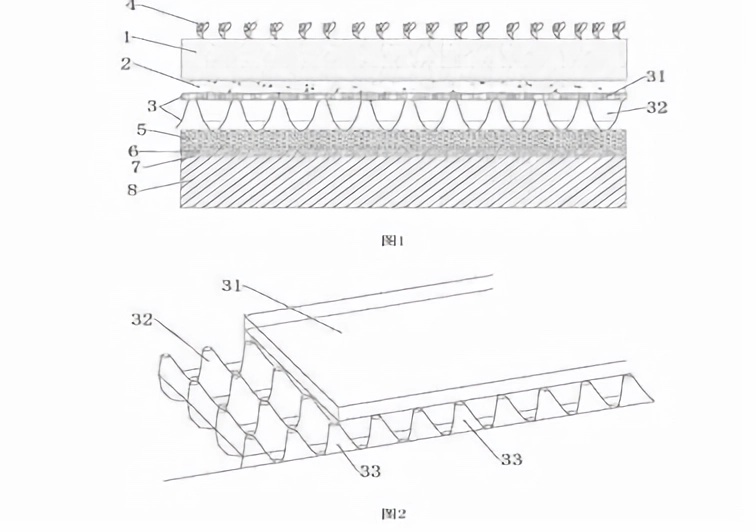
Figure 3. Aquifer schematic drawing [22].
In this design, the roof garden aims to provide a recreational space for residents, it combines platforms for plant growth with the design of a pavilion. It is necessary to address stormwater runoff from the pavilion's roof. The main approach is to design a slope as figure 4 on the roof, allowing rainwater to flow naturally and prevent it from accumulating entirely on the roof. Additionally, rainwater gutters as figure 5 are designed to collect water from the roof and direct it into the storage layer. This design ensures that all plants can obtain water from the storage layer and solves the issue of insufficient rainwater reaching the plants beneath the pavilion.
|
|
Figure 4. Pavilion schematic drawing. | Figure 5. Rainwater gutter schematic drawing. |
4. Challenges and opportunities in roof garden construction
Roof gardens face three main issues: load-bearing, waterproofing, and safety concerns. In terms of load-bearing, the capacity of the roof to support a garden must be assessed and evaluated due to limitations imposed by the underlying foundation [23]. This load-bearing issue cannot be ignored because it adds to the overall cost. Since some roof designs may not be able to accommodate a roof garden, further design considerations are necessary to adapt to existing buildings. Regarding waterproofing, the strong penetration capability of vegetation roots in roof gardens can potentially affect the existing waterproofing layer and even lead to concrete cracking, compromising the overall structural stability of the building [7]. Finally, there are safety concerns for roof gardens. To reduce the impact on the roof's load, lightweight vegetation is often chosen during the design process. However, considering the strong wind forces experienced by buildings, especially high-rise structures [24]. It is necessary to reinforce the vegetation, soil, and related facilities of the roof garden to prevent safety hazards caused by falling objects from heights.
Despite these challenges, roof gardens offer unique prospects and opportunities. Firstly, they are economically and environmentally beneficial. Considering the high economic value of urban land, the construction of roof gardens provides an opportunity for second-time land development [20]. Conventional urban greening methods often involve high land acquisition costs, which can be effectively addressed through roof garden construction. Taking Xiangcheng Xuefu of Southwest Petroleum University in Chengdu as an example, the construction of a roof garden could save approximately 22 million RMB [20]. Secondly, roof gardens have extensive application prospects. With the rapid urbanization process, the problems associated with urbanization become increasingly apparent. Many cities have plans to address these issues, such as the construction of garden cities in Chengdu. Therefore, roof gardens have broad application prospects, especially with the support of relevant policies, which can facilitate their implementation.
5. Conclusion
In the process of urbanization, challenges such as noise pollution, air quality issues, and urban heat island effects are commonly observed. This paper takes Chengdu City as an example and explores the potential role of roof gardens in addressing these issues. The study adopts the design of a roof garden and utilizes BIM (Building Information Modeling) technology for three-dimensional modeling to concretely represent the design outcomes, including infrastructure, structural layout, plant configuration, and materials within the roof garden. Subsequently, a preliminary qualitative analysis is conducted to determine the significant roles of the roof garden in promoting recreational activities for residents and mitigating urban noise. The research findings of this study are as follows.
Regarding the environmental issues and natural climate of Chengdu, selecting appropriate plant configurations is beneficial for improving air quality. By selecting shrubs with stable dust-retention effects, and trees with carbon sequestration, oxygen release, and heat absorption effects, on top of green lawn areas, the roof garden can contribute to air quality improvement. In addition, to adapt to the local climate of Chengdu, major plant configurations include large-leaved boxwood, hibiscus, and magnolia as trees; red-flowered treeline, rose, and Malus spectabilis as shrubs; and Scleranthus, hanging basket plants, and trifoliate herbs, etc. In terms of controlling rainwater runoff, this paper introduces a water storage layer to the roof garden. On the one hand, the water storage layer increases the water retention capacity of the rooftop garden, which is advantageous for controlling the volume of rainwater runoff. On the other hand, water storage can prevent excessive saturation of water in the rooftop garden contribute to pollutant control and minimize their adverse effects.
Although this research focuses only on Chengdu as a case study, the results can be widely applied to other cities. The plant configuration of the roof garden can be modified according to specific urban needs to address different air pollutants. However, as a nascent technology, roof gardens still face some challenges, such as improving water retention performance and reducing the weight of rooftop gardens. These issues require further research and resolution. Nevertheless, with its unique advantages in the secondary development of urban land and effective responses to urban issues, rooftop gardens demonstrate vast potential. Especially with the support of policies like Chengdu's "Garden City" planning, rooftop gardens have significant prospects in addressing urban problems.
References
[1]. Giama E, Papageorgiou C, Theodoridou I and Papadopoulos A M 2021 Life Cycle Analysis and Life Cycle Cost Analysis of green roofs in the Mediterranean climatic conditions. Energy sources. Part A, Recovery, utilization, and environmental effects. ahead-of-print(ahead-of-print), pp 1–14
[2]. Liu C, Georgiou F and Hornikx M 2021 Characterization of the acoustic impedance of in-situ vegetated roofs. Applied acoustics. 171 p 107514
[3]. Alim M A, Rahman A, Tao Z, Garner B, Griffith R and Liebman M 2022 Green roof as an effective tool for sustainable urban development: An Australian perspective in relation to stormwater and building energy management. Journal of cleaner production. 362 p 132561
[4]. Statistic bureau of Chengdu, and NBS Survey office in Chengdu. 2019. Chengdu Statistical Yearbook. Chengdu: China Statistics Press.
[5]. Zhang L W, and Mao B P 2020 Charachteristics of climate change in Chengdu plain. J. Chengdu Univ. Inform. Technol. 35 (2) pp 179-187
[6]. Yuan J, Lin Q, Chen S, Zhao H, Xie X, Cai Z, Zhang J, Cheng T, Hua M and Zhang R 2022 Influence of global warming and urbanization on regional climate of Megacity: A case study of Chengdu, China. Urban climate. 44 p 101227
[7]. Jiang J 2017 Research on roof garden design. China Water Transport: The second half of the month. 17(8) pp 323-325
[8]. Wang J 2023 Plant landscape design of roof garden of commercial buildings -- taking "1+1" roof garden concept design of Xucheng Commercial Square as an example. Smart Buildings and Smart Cities. 4 pp107-110
[9]. Yao L 2020 Study on the design of commercial complex roof garden under the influence of microclimate -- A case study of Chengdu City. Master's thesis, Southwest Jiaotong University.
[10]. Zhong J, Li Z, Sun Z, Tian Y and Yang F 2020 The spatial equilibrium analysis of urban green space and human activity in Chengdu, China. Journal of cleaner production. 259 p 120754
[11]. Li A, Fan L, Xie L, Ren Y and Li L 2018 Associations between air pollution, climate factors and outpatient visits for eczema in West China Hospital, Chengdu, south‐western China: a time series analysis. Journal of the European Academy of Dermatology and Venereology. 32(3) pp 486–494.
[12]. Xu F, Yan S, Wu M, Li F, Xu X, Song W, Zhao J, Xu J and Kan H 2011 Ambient ozone pollution as a risk factor for skin disorders. British journal of dermatology (1951). 165(1) pp 224–225
[13]. Yan J, Zou X, Qin H, Yu Y, Chen, Huang J and Zhang Y 2023 Change trend of eco-environmental quality in Chengdu during the 13th Five-Year Plan period. Chinese Environmental Monitoring. 39(3) pp19-23
[14]. Hadi A S, Abd A M and Mahmood M 2021 Integrity of Revit with structural analysis softwares. IOP conference series. Materials Science and Engineering. 1076(1) p 12119.
[15]. Ramdhaniati M and Mulyanti B 2021 Lumion animation for digital learning: Is it applicable in both Industrial and educational contexts? IOP conference series. Materials Science and Engineering. 1098(2) p 22113
[16]. Miller S M and Montalto F A 2019 Stakeholder perceptions of the ecosystem services provided by Green Infrastructure in New York City. Ecosystem services. 37 p 100928
[17]. GSA 2011 The Benefits and Challenges of Green Roofs on Public and Commercial Buildings. A Report of the United States General Service Administration, US GSA. Available online: https://www.gsa.gov/cdnstatic/The_Benefits_and_Challenges_of_Green_Roofs_on_Public_and_Commercial_Buildings.pdf (accessed on 23 August 2023)
[18]. Fan X 2019 The Innovation Model Research of Roof Garden of Green Building. In: Environmental Science and Engineering. Cham: Springer International Publishing, pp 47–55
[19]. Wen J 2012 On the plant configuration of the roof garden in Leshan City. Sichuan Forestry Science and Technology. 33(6) pp 125-126,101
[20]. Yu Q J 2017 Study on the allocation and eco-economic benefits of green roofing plants in Chengdu. Sichuan Cement. 8 pp 221-223
[21]. Koc K, Ekmekcioğlu Ö and Özger M 2021 An integrated framework for the comprehensive evaluation of low impact development strategies. Journal of environmental management. 294 pp 113023–113023
[22]. Lin H M 2018 Roof garden. CN201820143502U 20180127
[23]. Tian Y and Jim C Y 2012 Development potential of sky gardens in the compact city of Hong Kong. Urban forestry & urban greening. 11(3) pp 223–233
[24]. Dong B Y 2023 Roof garden landscape design problems and solutions. Henan Building Materials. 6 pp 113-115
Cite this article
Liu,Z. (2024). Using roof garden to alleviate urbanization problems - A case study of Chengdu city. Applied and Computational Engineering,58,85-93.
Data availability
The datasets used and/or analyzed during the current study will be available from the authors upon reasonable request.
Disclaimer/Publisher's Note
The statements, opinions and data contained in all publications are solely those of the individual author(s) and contributor(s) and not of EWA Publishing and/or the editor(s). EWA Publishing and/or the editor(s) disclaim responsibility for any injury to people or property resulting from any ideas, methods, instructions or products referred to in the content.
About volume
Volume title: Proceedings of the 4th International Conference on Materials Chemistry and Environmental Engineering
© 2024 by the author(s). Licensee EWA Publishing, Oxford, UK. This article is an open access article distributed under the terms and
conditions of the Creative Commons Attribution (CC BY) license. Authors who
publish this series agree to the following terms:
1. Authors retain copyright and grant the series right of first publication with the work simultaneously licensed under a Creative Commons
Attribution License that allows others to share the work with an acknowledgment of the work's authorship and initial publication in this
series.
2. Authors are able to enter into separate, additional contractual arrangements for the non-exclusive distribution of the series's published
version of the work (e.g., post it to an institutional repository or publish it in a book), with an acknowledgment of its initial
publication in this series.
3. Authors are permitted and encouraged to post their work online (e.g., in institutional repositories or on their website) prior to and
during the submission process, as it can lead to productive exchanges, as well as earlier and greater citation of published work (See
Open access policy for details).
References
[1]. Giama E, Papageorgiou C, Theodoridou I and Papadopoulos A M 2021 Life Cycle Analysis and Life Cycle Cost Analysis of green roofs in the Mediterranean climatic conditions. Energy sources. Part A, Recovery, utilization, and environmental effects. ahead-of-print(ahead-of-print), pp 1–14
[2]. Liu C, Georgiou F and Hornikx M 2021 Characterization of the acoustic impedance of in-situ vegetated roofs. Applied acoustics. 171 p 107514
[3]. Alim M A, Rahman A, Tao Z, Garner B, Griffith R and Liebman M 2022 Green roof as an effective tool for sustainable urban development: An Australian perspective in relation to stormwater and building energy management. Journal of cleaner production. 362 p 132561
[4]. Statistic bureau of Chengdu, and NBS Survey office in Chengdu. 2019. Chengdu Statistical Yearbook. Chengdu: China Statistics Press.
[5]. Zhang L W, and Mao B P 2020 Charachteristics of climate change in Chengdu plain. J. Chengdu Univ. Inform. Technol. 35 (2) pp 179-187
[6]. Yuan J, Lin Q, Chen S, Zhao H, Xie X, Cai Z, Zhang J, Cheng T, Hua M and Zhang R 2022 Influence of global warming and urbanization on regional climate of Megacity: A case study of Chengdu, China. Urban climate. 44 p 101227
[7]. Jiang J 2017 Research on roof garden design. China Water Transport: The second half of the month. 17(8) pp 323-325
[8]. Wang J 2023 Plant landscape design of roof garden of commercial buildings -- taking "1+1" roof garden concept design of Xucheng Commercial Square as an example. Smart Buildings and Smart Cities. 4 pp107-110
[9]. Yao L 2020 Study on the design of commercial complex roof garden under the influence of microclimate -- A case study of Chengdu City. Master's thesis, Southwest Jiaotong University.
[10]. Zhong J, Li Z, Sun Z, Tian Y and Yang F 2020 The spatial equilibrium analysis of urban green space and human activity in Chengdu, China. Journal of cleaner production. 259 p 120754
[11]. Li A, Fan L, Xie L, Ren Y and Li L 2018 Associations between air pollution, climate factors and outpatient visits for eczema in West China Hospital, Chengdu, south‐western China: a time series analysis. Journal of the European Academy of Dermatology and Venereology. 32(3) pp 486–494.
[12]. Xu F, Yan S, Wu M, Li F, Xu X, Song W, Zhao J, Xu J and Kan H 2011 Ambient ozone pollution as a risk factor for skin disorders. British journal of dermatology (1951). 165(1) pp 224–225
[13]. Yan J, Zou X, Qin H, Yu Y, Chen, Huang J and Zhang Y 2023 Change trend of eco-environmental quality in Chengdu during the 13th Five-Year Plan period. Chinese Environmental Monitoring. 39(3) pp19-23
[14]. Hadi A S, Abd A M and Mahmood M 2021 Integrity of Revit with structural analysis softwares. IOP conference series. Materials Science and Engineering. 1076(1) p 12119.
[15]. Ramdhaniati M and Mulyanti B 2021 Lumion animation for digital learning: Is it applicable in both Industrial and educational contexts? IOP conference series. Materials Science and Engineering. 1098(2) p 22113
[16]. Miller S M and Montalto F A 2019 Stakeholder perceptions of the ecosystem services provided by Green Infrastructure in New York City. Ecosystem services. 37 p 100928
[17]. GSA 2011 The Benefits and Challenges of Green Roofs on Public and Commercial Buildings. A Report of the United States General Service Administration, US GSA. Available online: https://www.gsa.gov/cdnstatic/The_Benefits_and_Challenges_of_Green_Roofs_on_Public_and_Commercial_Buildings.pdf (accessed on 23 August 2023)
[18]. Fan X 2019 The Innovation Model Research of Roof Garden of Green Building. In: Environmental Science and Engineering. Cham: Springer International Publishing, pp 47–55
[19]. Wen J 2012 On the plant configuration of the roof garden in Leshan City. Sichuan Forestry Science and Technology. 33(6) pp 125-126,101
[20]. Yu Q J 2017 Study on the allocation and eco-economic benefits of green roofing plants in Chengdu. Sichuan Cement. 8 pp 221-223
[21]. Koc K, Ekmekcioğlu Ö and Özger M 2021 An integrated framework for the comprehensive evaluation of low impact development strategies. Journal of environmental management. 294 pp 113023–113023
[22]. Lin H M 2018 Roof garden. CN201820143502U 20180127
[23]. Tian Y and Jim C Y 2012 Development potential of sky gardens in the compact city of Hong Kong. Urban forestry & urban greening. 11(3) pp 223–233
[24]. Dong B Y 2023 Roof garden landscape design problems and solutions. Henan Building Materials. 6 pp 113-115










